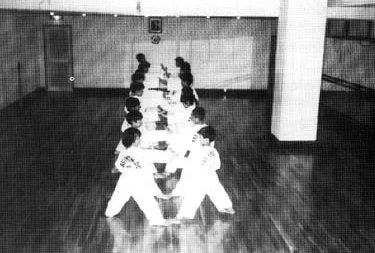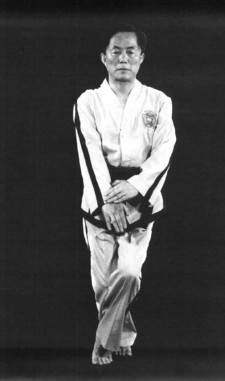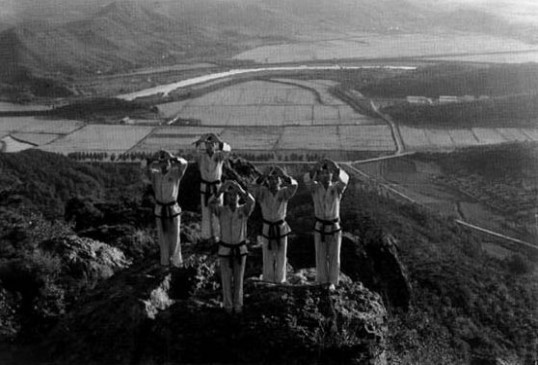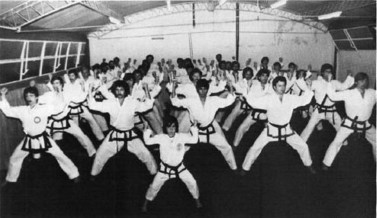ARTICLES The Application Secrets Of The Patterns by W Rhee |
There are certain assumptions in ITF forms! It should be noted: a. Not all movements are intended for actual applications to the opponent, some are intentionally included to condition the muscles and reflexes. Lower belt forms will have more fist tensed movements. As you progress, more open hand movements are introduced along with close encounter techniques. b. Applications are open to be discovered. There is no one set of application. If it works smoothly when applied in a real fighting situation, so be it. If it is an overly contrived interpretation and does not flow after many tries, you are heading in the wrong direction. c. Each GM has their own interpretation. d. Higher forms emphasize the hand techniques not introduced in the color belt forms. This is where many people miss out on TKD. TKD actually has lot more hand techniques than it is credited for-if you stayed in the art long enough beyond 1st degree BB. e. Most important, all movements in the forms emphasize the conditioning of the action-reaction principle. It teaches you how to chamber, get into the "rhythm"(if you haven't gotten this in any pattern, you are not learning it right), and deliver the efficient force. Each movement in the ITF pattern sets up to the next movement by using the action/reaction movement and the momentum resulting from it. eg. when you are doing a spinning back kick = back turning kick, the principle of the force is similar to David's sling shot to Goliath or a discus thrower. You accelerate your foot/body into a circular motion in order to maximize and execute a final straight thrust. Then the thrust's movement is set up for the next movement and so on. This way, all movements transition smoothly in a form. For instance in kicking, in order to create the momentum, you have to rotate/pull your torso *opposite* of the direction you are delivering. In order to do this, balance, proper generation of power, and muscle coordination must be maintained. Forms train you for this. f. God forbid if you took the techniques literally and applied them exactly as done in the forms. It simply does not work. Some TKD instructors and their students think the patterns have it all and should reflect the application as is in the patterns. They are only a point of reference and will not work if you did them in real application with the exact same movements. You have to modify them (usually beginning from red belt or BB 1st degree up). g. Any movement is not clear cut black and white as to what is offense and what is defense. They usually entail both. Eventually you will realize that blocks specifically target pressure points for immobilization. You can use varied combinations. If you don't get it now, you will get it later. Higher forms have the chi-component. Your energy is not as diverted in the stiff stopping block with a tensed fist. Open hand blocks actually are intended for "water-principle". This you will get later as well, one example is you do not use a stiff stopping motions with the knife hand in real life, but a deflecting push-through motion. Some blocks, as I mentioned in the beginning, they are not supposed to work. They are point of reference for modifications. If you are trapped in that thought mode, somebody is in real trouble. Even when a bona fide classical/traditional GMs spar, everything seems to go out the door. eg. Standard middle section punch where your waist is still in traditional TKD, in actual fighting, your twist your waist for deep thrust to the opponent, rapid switching of the feet play never taught in the basic movements or patterns, etc. Eventually they are supposed to open up(closed fist to open knife-hand), and when blocking against any movement, you are supposed to block *BEFORE* the opponent's technique is complete. Most TKD techniques snap just like wet towel tip snapping. If you block the wet towel before it snaps, you neutralize the power/force before it reaches its potential. Same principle applied in TKD blocks. And as you block an opponent's move, you simultaneously strike a pressure/nerve point on the incoming leg/foot/hand which will neutralize the opponent. This is another lost art of TKD today. In my case, I always check on my timing for the opponent's movement. Whether a certain technique from patterns work or not is up to your handling of it, not the technique itself. Furthermore, there are also feints. The forearm blocks before the kick is completed, and at that point, you have should have multiple follow-ups to other body areas of the opponent without even thinking. If you work on tit-for-tat techniques as found in the patterns to be applied in real life, you have got ways to go. In the traditional TKD, all movements start from the left first because most people are right handed. When they attack, they will with their right hand. The best counter to the opponent's right hand is your left one. That is why most movements in the patterns (there are exceptions like Gwang ge) start from the left side because the emphasis is on the defense. Example: Midsection inner forearm block is to be used in close encounter self-defense techniques and before the attack is completed. Plus the purpose is to strike a pressure/nerve point in the incoming hand/arm as you do the block. Yes, there are points on the arm where the whole arm will go numb. It is a set up for a body rotation for a follow up techniques. Again it is before the opponent completes their move, you block and using the momentum, the close encounter circular blocks or strikes come into play. eg. Right inner forearm block incompletes the opponent's attack, you then rotate your body with the momentum you have generated and attack with the left arm. Multiple follow-ups are expected in my students. Plus in sparring, your main technique should never be the initiating action, but led into action by another, i.e. combinations. -The next stage after application is the body pressure points they use in Chinese medicine. But that is a whole new realm, Dillman is only touching the surface. He really does not understand the whole concept. There is more to it. (No offence intended) The meanings of the patterns or interpretation does not sink in unless you have done it quite a while. Jhoon Rhee (no relation) suggests doing it minimum of 300 times. Even Chun-Ji I have done it probably over few thousand times and I have recently understood it. Because the movements of attack/defense in TKD forms does not involve the conscious intellectual mind, but more of the intuitive mind (6th sense). When someone asks me how to do it step by step, I usually find it difficult. It only "comes" to life, when I do it by going through it. It is because one technique flows/sets up/initiates the next one. After you get his, then, you start picking up the hidden applications. It all boils down to basics, basics, basics. Eventually after understanding the basics and making them "part of you" then you will start understanding the applications and reasons behind the movement. Otherwise you end up with paralysis by analysis. Further Reading on this subject: Patterns: Are we Missing The Point |
ARTICLES The Application Secrets Of The Patterns by W Rhee |



